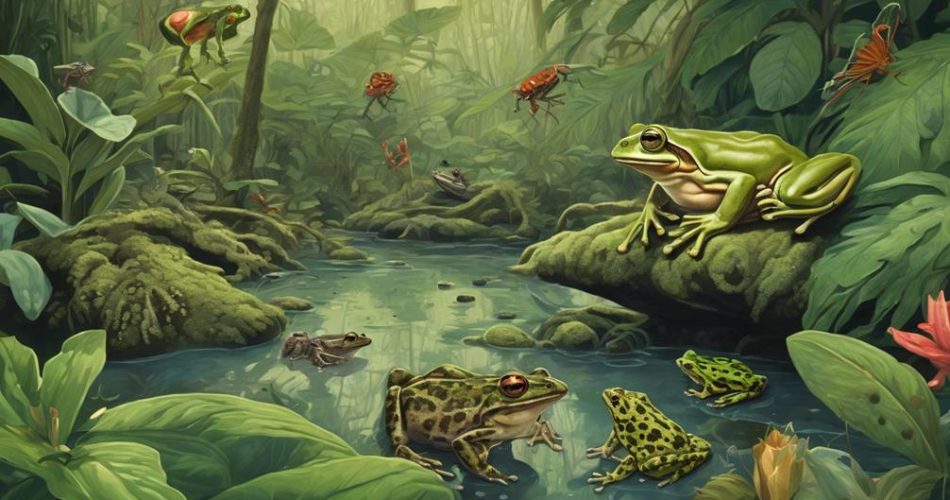Imagine you're standing at the edge of a river in Cameroon, watching a Goliath Frog leap from a nearby rock. It's the largest frog you've ever seen – they can grow up to 33cm long.
These extraordinary amphibians are unique to the rainforests and rivers of Equatorial Guinea and Cameroon, but their habitat is under threat.
If you're intrigued as to what makes them so important to their ecosystem and why their dwindling numbers could have a larger impact than you'd expect, then stay tuned.
Key Takeaways
- The Goliath Frog, the world's largest frog, is found in the rainforests of Cameroon and Equatorial Guinea, thriving in fast-flowing rivers and humid conditions.
- It plays a significant role in the ecosystem by controlling insect populations and serving as an indicator of environmental health.
- Threats to its survival include deforestation, pollution, over-harvesting, and diseases such as Chytridiomycosis.
- Conservation efforts involve population monitoring, threat mitigation strategies, and cooperation among researchers, conservationists, local communities, and policymakers.
Goliath Frog: An Overview
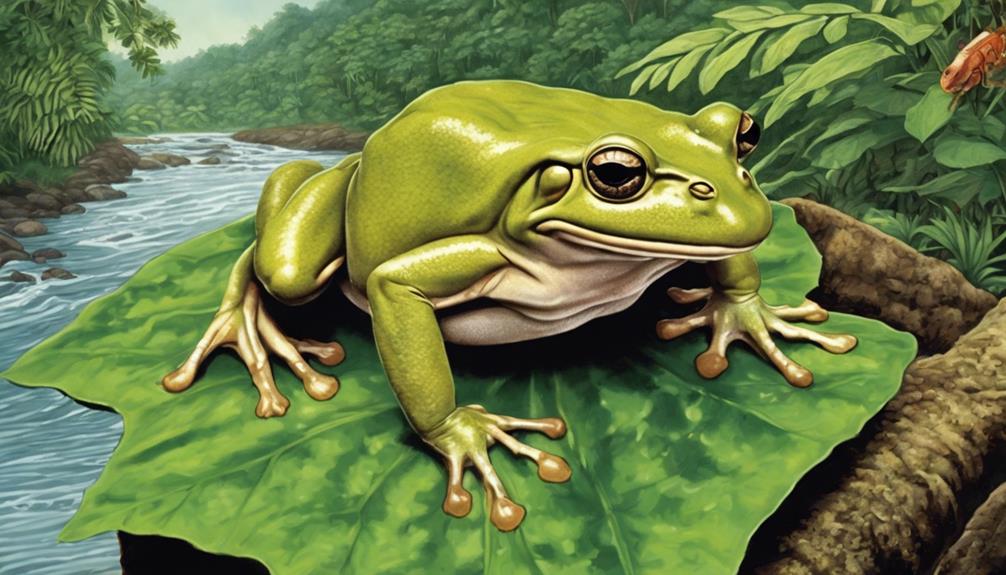
Diving into the world of amphibians, you'll find the Goliath frog, a colossal creature that dominates its ecosystem with its astonishing size and distinctive characteristics. Known as the largest living frog, it commands attention, not just for its massive size, but also for its unique attributes, including its lifespan and breeding patterns.
Focusing on the frog lifespan, the Goliath frog's longevity is something that intrigues scientists. Unlike most frogs that live for a few years, the Goliath frog has an impressive lifespan, living up to 15 years in the wild. This extended lifespan gives it a competitive advantage in its ecosystem, allowing it to dominate for a more extended period.
Switching gears to look at breeding patterns, you'll find that Goliath frogs exhibit unique traits. They're noted for their breeding season, which is between July and August. During this period, the males construct nests in riverbanks, showcasing a level of tool-use behaviour that's rarely seen in amphibians. Unlike other frogs that lay hundreds of eggs, the Goliaths lay fewer, larger eggs, indicating a different reproductive strategy that prioritizes quality over quantity. These factors significantly contribute to their imposing presence in their ecosystem.
Habitat and Geographic Distribution
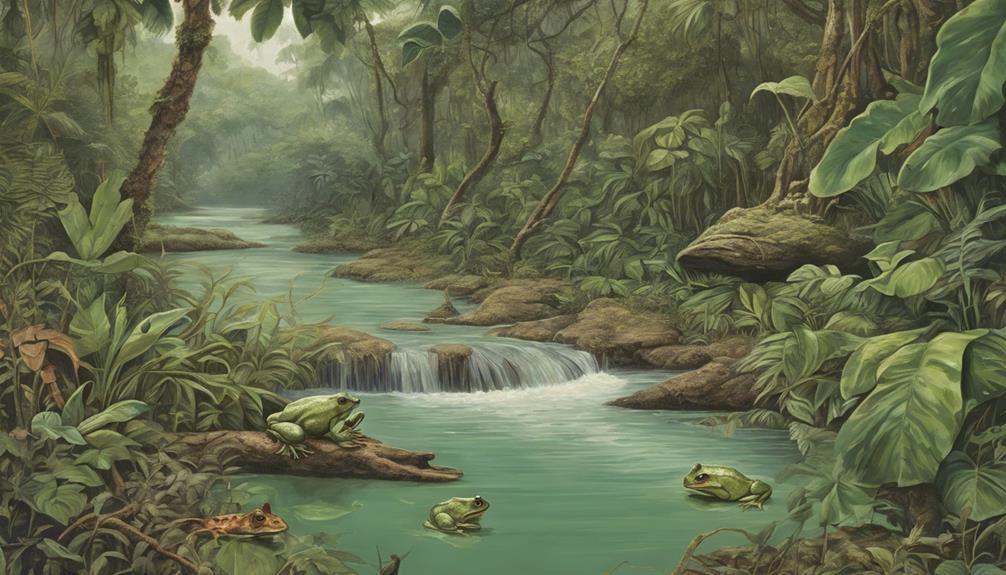
Amid the dense, verdant rainforests of Western Africa, you'll find the exclusive habitat of the Goliath frog, a locale characterized by fast-flowing rivers and humid conditions, perfectly suited to the needs of this amphibian giant. These regions, specifically in Cameroon and Equatorial Guinea, offer the optimal blend of temperature, humidity, and water flow necessary for the frog's survival.
However, the Goliath frog's natural domain is under constant threat from habitat destruction. Deforestation, mining, and human settlement encroachment strip away the critical resources these frogs need to thrive. This destruction not only reduces the available space for the frogs but also disrupts their breeding sites, further threatening their survival.
Interestingly, the Goliath frog exhibits remarkable geographic adaptation. Despite the challenging circumstances, these creatures manage to adapt, even in fragmented habitats. They've been found in secondary forests and areas with sparse vegetation, indicating a level of resilience. Nevertheless, this adaptation doesn't completely offset the impact of habitat loss.
Diet and Predation
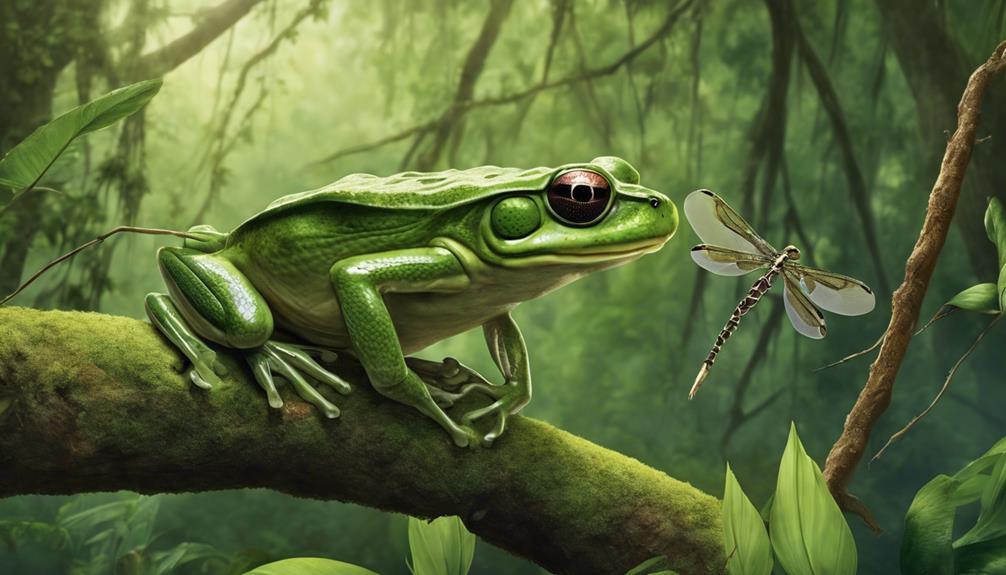
While the Goliath frog's resilience in the face of habitat destruction is commendable, understanding their dietary habits and the predation they face is equally crucial to their survival story. You should know that Goliath frogs are carnivorous, feeding primarily on insects, spiders, crustaceans, and small fish. They also consume smaller frogs, demonstrating the opportunistic dietary behavior common to many amphibians.
The adult frog's lifespan, which can extend up to 15 years in the wild, is influenced by both diet and predation. These frogs are active predominantly at night, reducing the risk of predation. Yet, their size doesn't entirely shield them from danger. Predators, like large birds, snakes, and even other larger amphibians, pose significant threats.
During the reproduction cycle, the risks increase. Eggs and tadpoles are vulnerable to predation by various aquatic species. They're also susceptible to infection by parasites and disease, adding another layer of complexity to their survival. Thus, diet and predation directly impact the Goliath frog's lifespan and reproduction cycle, shaping their existence in the ecosystem. Understanding these factors is pivotal in preserving and protecting these remarkable creatures.
Role in the Ecosystem
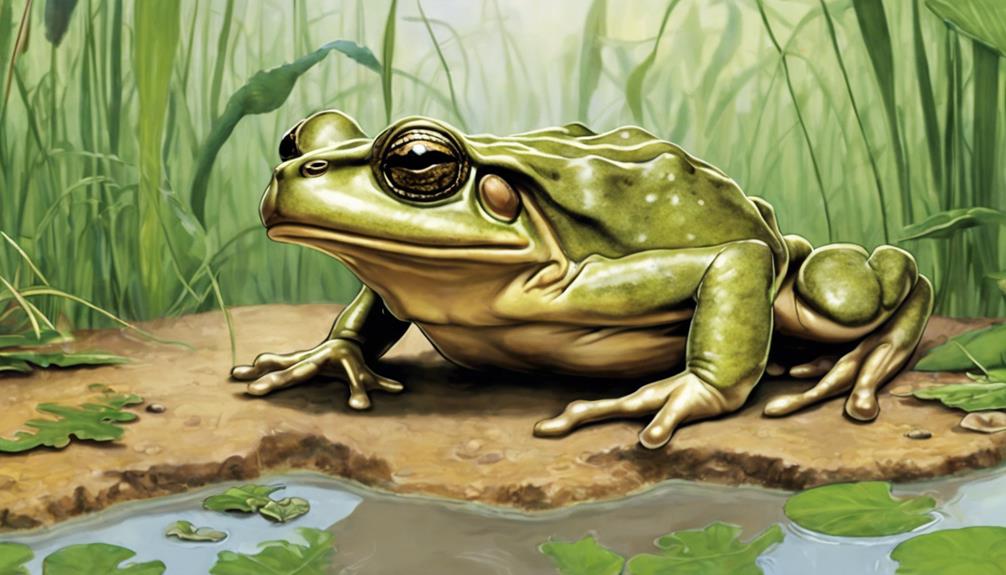
In understanding the Goliath frog's role in the ecosystem, it's essential to consider its interactions with both biotic and abiotic components of its environment. As the largest living amphibian, its presence alone significantly influences its surroundings.
Firstly, let's delve into frog reproduction. Goliath frog's unique breeding strategy involves the male crafting intricate pond-like nests, vital for the survival of their eggs and tadpoles. These nests, in turn, alter the physical landscape, modifying water flow, and creating microhabitats that support other species. Moreover, the tadpoles serve as a food source for various predators, thus contributing to the food chain.
Furthermore, they play an important role in controlling insect populations, which can be carriers of diseases and damage vegetation. However, the Goliath frog's immune system is vulnerable to amphibian diseases like Chytridiomycosis, which affects its survival rates and subsequently impacts the ecosystem balance.
Additionally, they serve as indicators of environmental health. Being extremely sensitive to changes in their habitat, any decline in their numbers could signal environmental degradation.
In a nutshell, Goliath frogs aren't just colossal amphibians; they're integral parts of their ecosystems, contributing to biodiversity, ecosystem function, and signaling environmental health.
Conservation Efforts and Challenges
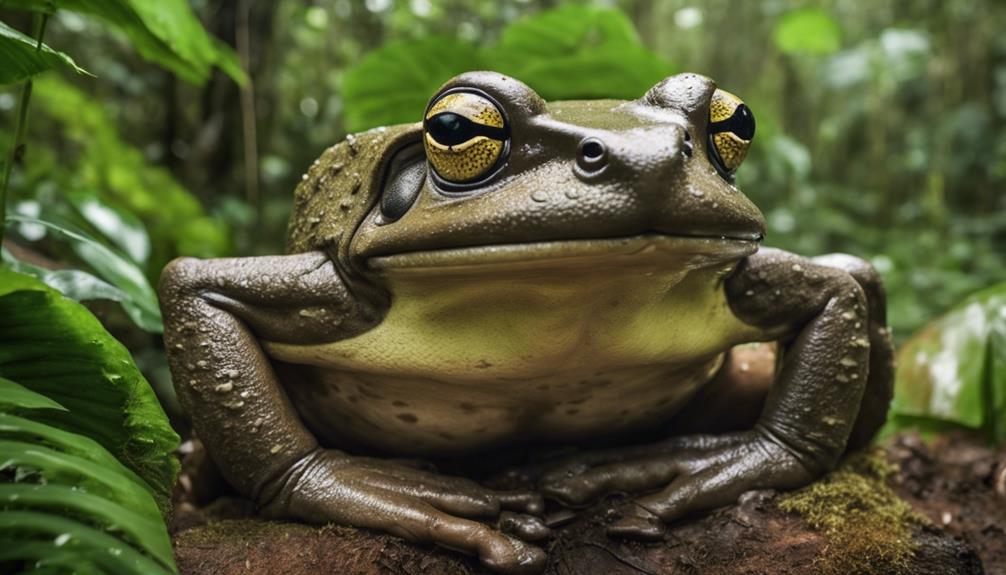
Despite their ecological importance, Goliath frogs face numerous threats, necessitating concerted conservation efforts and posing significant challenges. Deforestation, pollution, and over-harvesting for pet trade and local consumption are key threats. Threat Mitigation Strategies (TMS) are critical in addressing these issues. You'd find that TMS often encompass both direct and indirect actions. Direct actions may involve protecting their habitats, while indirect actions could include implementing policies and laws that regulate the collection and trade of these frogs.
Monitoring the population of Goliath frogs also forms a crucial part of these conservation efforts. Population Monitoring Techniques (PMT) enable scientists to keep track of the number of these frogs within their natural habitats, providing vital data for conservation planning. PMT can range from visual surveys to using technological tools like tracking devices and drones. The data collected helps in identifying trends in population size and distribution, which can guide targeted conservation actions.
However, these efforts aren't without challenges. Limited funding, lack of local community involvement, and inadequate scientific research pose significant hurdles. Consequently, it's vital to bolster cooperation between researchers, conservationists, local communities, and policymakers to ensure the survival of these magnificent creatures.
Frequently Asked Questions
What Is the Lifespan of a Goliath Frog in the Wild Versus in Captivity?
You're curious about the lifespan of Goliath frogs in the wild versus captivity. In the wild, they can live up to 15 years, fueled by a diet rich in insects and small fish.
In captivity, it's a different story. Despite efforts, they don't fare as well due to challenges in replicating their diet and environment. Their lifespan shortens significantly, often not surpassing a few years.
This issue underscores the importance of preserving their natural habitat.
Can Goliath Frogs Coexist With Other Frog Species or Do They Have Territorial Tendencies?
Yes, you'll find Goliath frogs coexisting with other frog species in their natural habitat. They don't exhibit territorial tendencies as such.
However, their diet, largely consisting of small invertebrates and other frogs, could potentially lead to interspecies competition. Threat predators, such as large birds and snakes, also influence their cohabitation dynamics.
It's a delicate balance in the ecosystem where they must coexist, compete, and avoid predation.
Are There Any Unique Behavioral Patterns or Mating Rituals Associated With the Goliath Frog?
Yes, Goliath frogs have unique behaviors. They're nocturnal and exhibit lek mating, where males congregate and compete for females.
Diet-wise, they're carnivorous, consuming crustaceans, fish, and other amphibians.
In terms of amphibian communication, it's fascinating that despite their size, they don't vocalize. Instead, they use visual and vibrational signals to communicate, especially during mating season.
Their behaviors reflect adaptations to their habitat and lifestyle.
How Has Climate Change Affected the Goliath Frog's Population and Habitat?
Climate change's impacts are significantly affecting the goliath frog's population and habitat. Warmer temperatures and inconsistent rainfall patterns are disrupting their breeding cycles, causing a population decline.
Additionally, increased droughts and flooding are destroying their habitats, forcing them to migrate to less suitable environments. It's crucial for you to understand these effects, as they're threatening the survival of this unique species.
What Are the Potential Medical or Scientific Uses for Goliath Frog's Biological Materials, Such as Their Skin or Secretions?
You're exploring the potential of goliath frog's biological material utilization in medical or scientific fields. Their skin or secretions could hold significant medicinal value.
Similar to other amphibians, they may contain bioactive compounds useful in medicinal frog research. These compounds could offer novel treatments for various ailments.
However, extensive research is required to uncover and understand the potential benefits and applications of these biological materials.
Conclusion
You've journeyed deep into the world of the Goliath frog. Living in unique habitats, consuming an exclusive diet, and playing a significant role in their ecosystem, they're truly fascinating creatures.
However, they're facing severe threats, needing urgent conservation efforts. Understanding and appreciating their ecological value is crucial to protect them.
Let's strive to preserve these giant amphibians, ensuring they continue to thrive and maintain the health of their ecosystems.


